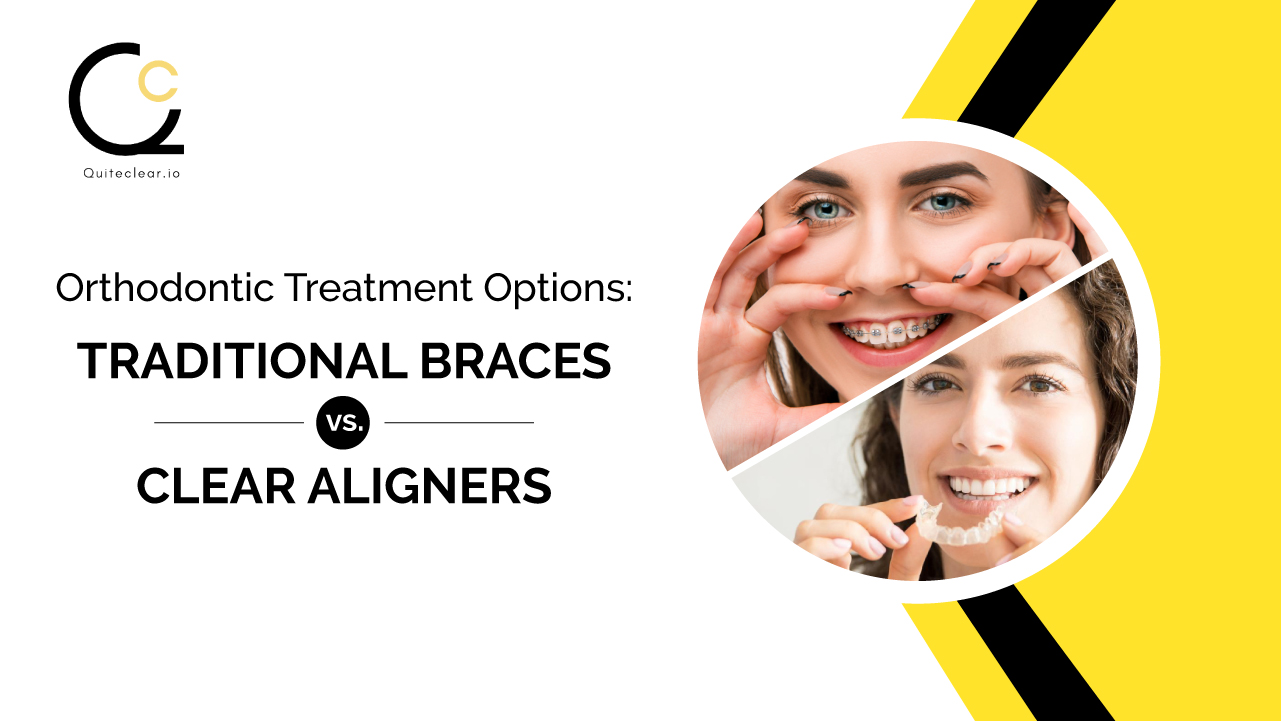Orthodontic Treatment Options: Traditional Braces vs. Clear Aligners

What are Orthodontic Braces?
Orthodontic braces are specialized dental devices used to correct misaligned teeth and jaws, enhancing both dental health and the aesthetics of a person’s smile. These devices apply continuous pressure to shift teeth into the desired position gradually. Braces are a common and effective solution for various dental issues, including crowding, gaps, and bite problems. Here’s a detailed overview:
Components of Orthodontic Braces
- Brackets: Small squares bonded directly to the front of each tooth using dental adhesive. Brackets serve as handles that hold the archwires.
- Archwires: Thin metal wires that run through the brackets, guiding the movement of the teeth by applying consistent pressure.
- Bands: Metal rings placed around the back molars to anchor the archwires and provide additional support.
- Elastics (Rubber Bands): Small rubber bands attached to hooks on the brackets to help with tooth and jaw alignment.
- Ligatures: Tiny rubber bands or wires that hold the archwire to the brackets.
- Coil Springs: Springs placed on the archwire between brackets to push, pull, open, or close spaces between teeth.
Types of Orthodontic Braces
There are several types of orthodontic braces available, each with unique features to cater to different needs and preferences:
- Traditional Metal Braces: Made of high-grade stainless steel, these are the most common type. They involve metal brackets and wires.
- Ceramic Braces: Similar to traditional braces but with tooth-colored or clear ceramic brackets that blend in with the teeth, making them less noticeable.
- Lingual Braces: Attached to the backside of the teeth, making them virtually invisible from the front.
- Clear Aligners: Custom-made, clear plastic trays that fit over the teeth and can be removed for eating and cleaning. They are nearly invisible when worn.
How Orthodontic Braces Work
Braces apply continuous pressure over time to move teeth in a specific direction. The process includes several stages:
- Initial Assessment: An orthodontist examines the teeth, takes X-rays, and creates a treatment plan tailored to the patient’s needs.
- Application: Brackets are bonded to the teeth, and archwires are threaded through the brackets.
- Adjustment: Periodic adjustments are made to the braces by tightening or changing the wires to ensure the teeth continue to move correctly.
- Retention: After the braces are removed, a retainer is usually worn to keep the teeth in their new positions and prevent relapse.
Benefits of Orthodontic Braces
- Improved Oral Health: Correcting misaligned teeth helps in better cleaning and reduces the risk of cavities and gum disease.
- Enhanced Aesthetics: Straightened teeth and aligned jaws contribute to a more attractive smile.
- Better Functionality: Properly aligned teeth improve bite and chewing efficiency.
- Prevention of Further Dental Issues: Correcting alignment can prevent wear and tear on teeth, jaw pain, and other orthodontic issues.
Duration of Treatment for Orthodontic Braces
The duration of orthodontic treatment varies depending on the complexity of the case. Typically, it ranges from 18 months to 3 years. Regular visits to the orthodontist are necessary for adjustments and to monitor progress.
Orthodontic braces are a proven and effective solution for achieving a healthier, more aesthetically pleasing smile, suitable for both children and adults requiring dental corrections.
What are Tooth/Teeth Clear Aligners, Invisible Braces, or temporary braces?
Tooth/Teeth Clear Aligners
Clear aligners are a modern orthodontic treatment that uses a series of custom-made, clear plastic trays to move teeth into their desired position gradually. They are nearly invisible when worn, making them an attractive option for those seeking a discreet solution.
Key Features of Clear Aligners:
- Custom-Made: Each set of aligners is tailored to fit the patient’s teeth precisely.
- Removable: Aligners can be taken out for eating, drinking, brushing, and flossing, offering flexibility and ease of use.
- Comfortable: Made of smooth plastic, they are less likely to irritate the gums and cheeks compared to traditional braces.
- Effective: Clear aligners can address a wide range of dental issues, including overcrowding, gaps, and bite problems.
- Aesthetic: The clear aligner teeth appliance is barely visible when worn so the treatment for malocclusion can be done discretely not causing any aesthetic displeasement to the wearer.
Ceramic Braces
Invisible braces can refer to either clear aligners or ceramic braces. Ceramic braces are similar to traditional metal braces but use clear or tooth-colored brackets and wires, making them less noticeable.
Key Features of Ceramic Braces:
- Less Noticeable: Ceramic braces blend in with the natural color of teeth, making them less conspicuous than metal braces.
- Fixed: Unlike clear aligners, ceramic braces are fixed to the teeth and can only be removed by a dentist or orthodontist.
- Durable: While strong, the ceramic brackets can be more brittle than metal ones, requiring careful maintenance.
Temporary Braces
Temporary braces are usually short-term orthodontic devices designed to address minor dental issues quickly. They can include both clear aligners used for a short period and fast-acting traditional braces designed for quicker results.
Key Features of Temporary Braces:
- Short-Term Use: Typically worn for a shorter period compared to traditional braces, usually a few months.
- Focused Treatment: Used to correct specific minor issues, such as slight crowding or spacing between teeth.
- Removable or Fixed: Temporary braces can be either clear aligners (removable) or a short course of fixed braces.
Summary of Differences in Tooth/Teeth Clear Aligners, Invisible Braces, or Temporary Braces:
- Metal Braces: Fixed braces, the most affordable option.
- Clear Aligners: Removable, nearly invisible, custom-made plastic trays.
- Ceramic Braces: Ceramic braces are which are less noticeable fixed braces.
- Temporary Braces: Short-term orthodontic solutions, either removable or fixed, used for minor corrections.
Which is Better: Aligners or Braces?
Deciding whether clear aligners or traditional braces are better for you depends on various factors, including the severity of your dental issues, lifestyle preferences, and budget. Here’s a detailed comparison to help you make an informed decision:
| Clear Aligners | Traditional Braces |
| Pros | |
| Aesthetics: Nearly invisible, making them a popular choice for adults and teens who want a discreet orthodontic treatment. | Effectiveness: Can treat a wide range of dental issues, including severe misalignment, significant gaps, and complex bite problems. |
| Comfort: Made of smooth plastic, which is less likely to irritate gums and cheeks. | No Compliance Issues: Since they are fixed to your teeth, you don’t have to remember to wear them. |
| Removability: Can be taken out for eating, drinking, brushing, and flossing, allowing for easier oral hygiene and no dietary restrictions. | Variety of Options: Available in metal, ceramic, or lingual (behind the teeth) options. |
| Convenience: Fewer visits to the orthodontist since several sets of aligners can be given at once. | |
| Cons | |
| Discipline Required: Must be worn for 20-22 hours a day; forgetting to wear them can prolong treatment. | Aesthetics: More noticeable than clear aligners, especially metal braces. |
| Not Suitable for All Cases: Less effective for severe or complex orthodontic issues like significant misalignment, large gaps, or severe bite problems. | Comfort: Can cause discomfort or irritation to gums and cheeks. |
| Potential for Loss: Since they are removable, there is a risk of losing or misplacing them. | Oral Hygiene: Brushing and flossing require more effort, and certain foods need to be avoided to prevent damage to the braces. |
| More Frequent Orthodontist Visits: Regular adjustments are necessary, leading to more frequent visits to the orthodontist. | |
Are Quiteclear Aligners Less Painful than Braces?
Quiteclear aligners are generally considered less painful than traditional braces. Since they are made of smooth plastic, they do not have the sharp edges and protruding parts that metal braces do, which can cause irritation and sores in the mouth. While there might still be some discomfort as the teeth adjust to each new set of aligners, it is usually less intense and short-lived compared to the discomfort often experienced with braces, especially after adjustments.
Is there Support for Dentists Throughout the Clear Aligner Treatment Process from Quiteclear?
Yes, Quiteclear provides comprehensive support for dentists throughout the treatment process. This includes ongoing guidance in case of fitment issues to help recognize the problem area and access to a support team that can assist with any questions or issues that arise. Dentists can monitor the progress of their patients and make adjustments as needed, ensuring that the treatment stays on track and any concerns are promptly addressed.
What Is the Duration of Clear Aligner Treatment?
Clear aligner treatment typically lasts between 6 to 18 months, depending on the complexity of the case. Regular dental check-ins help ensure progress is on track.
What is the Best Option for Straightening Teeth?
The best option depends on your dental needs, preferences, and budget. Clear aligners are discreet and comfortable for mild to moderate issues. Traditional braces are effective for severe corrections. Consulting with an orthodontist will help determine the best choice for you.
Are Transparent Braces Good?
Yes, transparent braces like ceramic braces and clear aligners are effective and discreet. They are popular for their aesthetic appeal and comfort, making them a great choice for many patients.
To get started with your treatment for Clear Aligners as a patient consult your Orthodontist and ask them about their offering in Clear Aligners. Orthodontists can reach us directly at connect@quiteclear.io|+919909973333 to get clear aligners manufactured with us.
